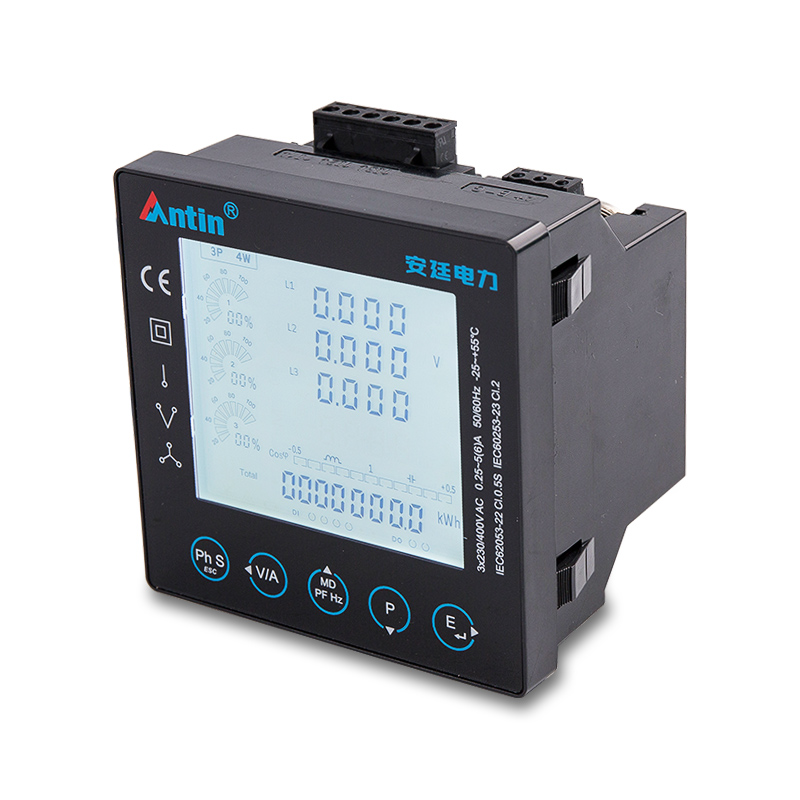Author: Admin
Date: Nov 11, 2025
Understanding the Multi-Function Power Meter: A Complete Guide
What is a Multi-Function Power Meter?
Definition and core functionality
- A Multi-Function Power Meter is an advanced electrical measurement device that simultaneously monitors multiple parameters such as voltage, current, power (active/reactive/apparent), power factor, frequency, energy consumption, and more.
- Unlike a simple energy meter that measures only cumulative kWh, the multi-function device provides rich data for real-time and historical analysis.
Evolution from simple energy meters
- The shift from traditional energy meters to multi-function meters reflects the growing need for energy management, power quality monitoring and smart grid integration.
- Modern multi-function meters support features like communication interfaces (Modbus, Ethernet), data logging, and integration into SCADA systems.
Why use a Multi-Function Power Meter for energy management systems
Key advantages in energy management
- Using a multi-function power meter for energy management systems lets you visualise all energy usage across equipment, circuits and systems.
- You can identify inefficiencies, track demand peaks, and optimise operational performance.
Industrial use versus commercial building use
- In industrial applications, a multi-function power meter captures complex parameters like harmonic distortion, phase imbalance, and reactive energy.
- In commercial buildings, the same device delivers insights into tenant billing, sub-metering, and energy cost allocation.
How to select a Multi-Function Power Meter for your application
Considerations for industrial use
- When selecting a multi-function power meter for industrial use, check for high accuracy, class 0.2 or class 0.5, as industrial power systems demand precision.
- Look for features such as harmonic measurement, real-time waveform capture, multiple I/O and rugged environmental ratings.
Considerations for commercial buildings
- A meter designed for commercial buildings emphasises ease of installation, scalability, clear displays, and communication with building automation systems.
- The benefit of a benefits of multi-function power meter in commercial buildings lies in tenant billing, energy dashboards, and compliance reporting.
Feature checklist: real-time monitoring, voltage, current etc.
- A robust feature set includes: real-time monitoring of voltage, current, power factor; energy consumption tracking; event/error logging; communication interface.
- Using a multi-function power meter features real-time monitoring voltage current helps maintenance teams detect anomalies early and reduce downtime.
Installation guidelines and panel meter applications
- Proper installation is critical: ensure correct CT/PT ratios, wiring, grounding, and configuration of communication settings.
- In the context of installation guidelines multi-function power meter panel meter application, place the meter in accessible panels, set up alarm thresholds, and integrate data into energy monitoring platforms.
How the Multi-Function Power Meter compares to traditional energy meters
Comparison table
| Feature | Traditional Energy Meter | Multi-Function Power Meter |
|---|---|---|
| Parameters measured | kWh only | Voltage, Current, Power (active/reactive/apparent), PF, Frequency, Energy, Harmonics |
| Data granularity | Monthly or cumulative | Real-time, historical, event-based |
| Communication | Minimal or none | Modbus, Ethernet, IoT interfaces |
| Use case | Simple billing | Energy management, sub-billing, power quality, predictive maintenance |
Best practices when implementing a Multi-Function Power Meter
Integration with energy management and monitoring systems
- Connect the meter output to your energy management software or SCADA to visualise and analyse energy flows.
- Set up dashboards to track key performance indicators (KPIs) like demand peaks and energy cost per unit.
Maintenance, calibration and data usage
- Ensure periodic calibration and firmware updates to maintain accuracy and reliability.
- Use logged data to perform root-cause analysis of anomalies; schedule preventive maintenance based on trends.
About our company: Hangzhou Antin Power Technology Co., Ltd
Company profile and expertise
- Located in Hangzhou, China, known as the “Silicon Valley of Paradise”. Established in 2013, Antin Power is one of the leading manufacturers and suppliers of electricity meters and energy measurement solutions to help worldwide customers visualise all energy usage and improve productivity and energy efficiency.
- Over the years, Antin Power has developed a wide range of products including DIN-rail energy meters, multi-function energy meters, prepaid energy meters, panel meters, etc., which could be widely used in applications like energy management and monitoring systems, sub-billing systems, electrical SCADA system etc.
How our product range supports multi-function power meter applications
- Our multi-function energy meters deliver the capabilities expected of a Multi-Function Power Meter — real-time multi-parameter monitoring, communication interfaces, reliability and accuracy.
- With our strong focus on R&D and collaboration with well-established universities and institutions, Antin Power supports clients in implementing robust energy monitoring setups across industrial, commercial and utility sectors.
To summarise, a Multi-Function Power Meter offers far more than a simple energy meter — it provides rich real-time data, supports energy management, enables power quality monitoring and supports decision-making for efficiency and cost savings. By choosing the right device based on application (whether industrial or commercial), and by following best practices for installation and integration, you can unlock significant value in your energy monitoring strategy. At Antin Power, we are committed to helping you visualise your energy usage and optimise your operations.
FAQ
- Q1: What is the difference between a traditional energy meter and a multi-function power meter?
A1: A traditional energy meter typically measures only cumulative energy (kWh). A multi-function power meter, however, measures voltage, current, power, power factor, frequency, and other parameters in real time, enabling advanced monitoring and management. - Q2: Can a multi-function power meter be used in both industrial and commercial settings?
A2: Yes. In industrial settings it tracks complex power quality issues; in commercial settings it supports tenant billing, sub-metering and building energy management. (See the sections above.) - Q3: What key features should I look for when selecting a multi-function power meter?
A3: Look for measurement accuracy (class 0.2/0.5), communication interfaces (Modbus, Ethernet), real-time and historical data logging, support for multiple parameters (voltage, current, PF, harmonics), and robust integration capability. - Q4: How does installation of a multi-function power meter differ from a standard meter?
A4: Installation requires correct CT/PT ratio configuration, proper wiring, grounding, set-up of communication networks and may require integration into monitoring systems. (Refer to the installation guidelines section above.) - Q5: How can I use data from a multi-function power meter for energy savings?
A5: By analysing real-time and historical monitoring data you can identify energy waste, demand peaks, inefficiencies, set corrective actions, optimise load schedules and reduce costs — thereby improving productivity and energy efficiency.






